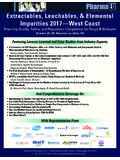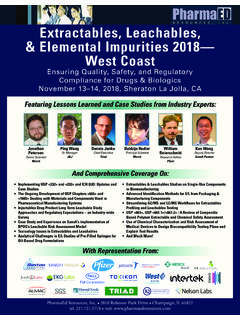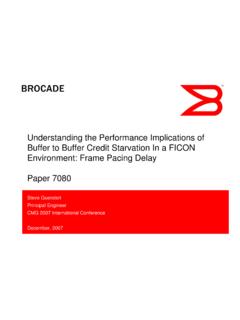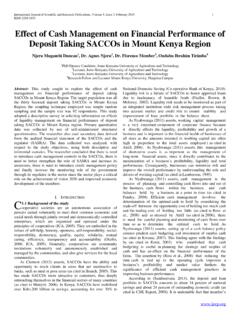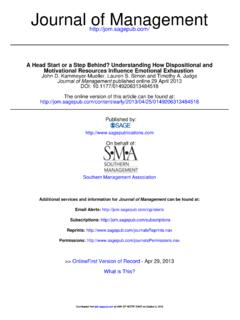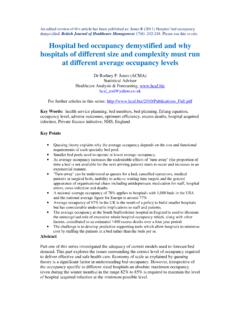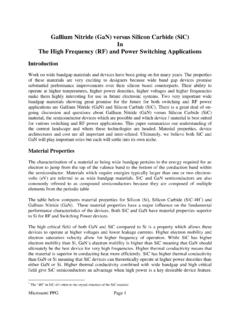Transcription of 2019 Transdermal and Intradermal - pharmaedresources.com
1 PharmaEd Resources, Inc. 2810 Robeson Park Drive Champaign, IL 61822tel. web. , Transdermal & Intradermal Drug Delivery Systems 2019 Advanced Design, Development & Delivery of Skin-Mediated Therapies and VaccinesSeptember 18 19, Metro Meeting Centers, Boston, MA Featuring Lessons Learned & Case Studies From Industry ExpertsAnd Comprehensive Coverage On:With Representation From: Next Generation MN Systems: Delivering High Drug Doses Transdermally Using Microarray Patches In Vitro Permeation Testing in Dermal Drug Discovery and Development Overcoming Unique Challenges Facing Skin Delivery Systems Delivering Therapeutic Peptides A Case Study Using a Solid Microstructured TD System Latest Advances in Microneedle Drug and Vaccine Delivery Optimizing Dissolving Microneedles & Coated Microneedles for Drug Delivery Improving Formulation Design in Dermal/ Transdermal Drug Delivery Mechanisms of Dermal and Transdermal Absorption of Drugs Regulatory and Experimental Considerations for Extractable and Leachable Analysis of TDD Systems Exploring the Therapeutic Potential of Cannabinoid Medicines Via Skin Delivery And more!
2 The growing interest in alternative routes of drug administration has experts predicting that the market for Transdermal and Intradermal drug delivery systems will exceed $30 billion in 2020. The industry is on the threshold of bringing into commercial production a new generation of transformative TDD and IDD therapies and delivery systems. That is why you cannot afford to miss this two-day intensive conference. Pharma Ed brings together leading researchers in the field to share the most recent advances in the design, formulation, and delivery of skin-mediated therapies and StinchcombUniversity of MarylandMikolaj MilewskiMerckLisa Dick3 MRyan DonnellyQueens CollegeNicky BertoloLatch MedicalTheo KapadnadzeDitebaHyungil JungJUVICD avid HoeyVaxxasDonald KellermanZosano PharmaAjay BangaMercer UniversityHarvinder GillTexas TechJasmine MusakhanianGattefoss Leandro SantosIncyte CorporationGyorgy VasIntertekMichael SchraderVaxess TechnologiesMichael RubertoMaterial NeedsCourtney JarrahianPathTanima SinhaDept.
3 Of Health & Human ServicesRegister Now to Guarantee Your Space! Online: Phone: , Transdermal & Intradermal Drug Delivery Systems 2019and possible synergies between excipients to drive molecules diffusion, partitioning, penetration, and per-meation. Providing examples and case studies, this pre-sentation explores the interpolations between the skin barrier properties, drug chemistry, and the excipient/sol-ubilizer choices that could help modulate the delivery of different types of molecules. 10:05 Exhibit Viewing & Networking Coffee BreakCritical Issues IVPT: Its Role in Drug Discovery & Development 10:40 In Vitro Permeation Testing in Dermal Drug Discovery and DevelopmentLeandro Santos, Associate Director, Clinical Sciences, Incyte CorporationIn vitro permeation testing (IVPT) has been used in the evaluation of semi-solid formulations, transder-mal and microneedle patches for over forty years and, while different apparatuses are available, the un-derlying concept is the same: a test article is applied on top of a biological membrane/appendage ( skin, nail), which interfaces with donor (occluded or non-occluded) and receptor compartments.
4 The latter is where the re-ceiving fluid (buffer) is present and can follow a static or flow-through a low-throughput technique, IVPT has some limitations in a discovery environment where multiple compounds and prototype formulations must be quickly screened during lead generation/optimization and drug development. Such barriers can be overcome by in sil-ico prioritization/selection of compounds, as well as improved bioanalytical and automation workflows. Ad-ditionally, IVPT data should always be put into context of other in vitro or in vivo models that can complement phar-macokinetic results with pharmacodynamic endpoints, yielding to early PK/PD correlations as a de-risking de-velopment strategy.
5 This presentation aims at discussing IVPT workflows used in dermal drug discovery across different topical dosage forms, and approaches on how to properly contextualize such results. 11:20 Experience Over 12 Months with Repeated Application of a Microneedle System in Phase III TrialDonald Kellerman, Vice President, Clinical Development, Zosano PharmaceuticalsZosano Pharma recently completed a 12-month, phase III safety study of Qtrypta zolmitriptan de-livered intracutaneously via microneedles. We will present select safety results, specifically pertaining to application site findings after repeated administration. 12:00 Complimentary Networking LunchWednesday, September 18, 2019 8:15 Complimentary Breakfast & Chairperson s Welcome and Opening RemarksMichael Eakins, President, Eakins & Associates Key Challenges and Opportunities in Non-Invasive Skin Delivery 8:45 Overcoming Unique Challenges facing Skin Delivery SystemsDr.
6 Ajay Banga, Chair & Professor of Pharmaceutical Sciences, Mercer UniversityUnique challenges facing non-invasive delivery of lipophilic and hydrophilic drugs into skin will be discussed. These challenges and potential solutions will be presented by way of examples from our research and will include discussion of delivery of an extremely lipophilic drug past epidermis into dermis, and require-ments of drug loading vs. drug crystallization in pressure sensitive adhesives to design 7-day Transdermal patches. Adapting in vitro permeation testing in Franz cells to ac-commodate delivery technologies such as iontophoresis, conducting in vitro microdialysis, and addressing prac-tical issues of rubbing, spreadability, lateral diffusion of drugs in skin, and considerations relating to size and isoelectric point of polypeptide drugs vs.
7 Skin pH will also be discussed. 9:25 Role of Drug, Excipient, and Formulation Design in Dermal/ Transdermal Delivery Jasmine Musakhanian, Scientific & Marketing Director. Gattefoss USAWith the few and far between trailblazing successes in Transdermal products, the prospects of drug de-livery across the skin in a non-invasive manner may appear unattainable for most API. Fortunately, the pros-pects are changing, given the huge body of work in re-cent years that have improved understanding of the skin physiology and the potential pathways for overcoming its barrier , progress has been made in the evaluation and char-acterization methods for assessing the suitability of one or another permeation enhancer relative to the drug at hand.
8 Combined, these advances enable a retrospec-tive analysis of the past publications under a new light, arriving therefore at guiding principles in formulation design which were not possible before. This presenta-tion highlights the implications of drug solubilization vs dispersion in the vehicle; selection of vehicle type(s); Register Now to Guarantee Your Space! Online: Phone: , Transdermal & Intradermal Drug Delivery Systems 2019 Laser sintered SLS 3D printing (MLabs, Germany) was used for the fabrication of stainless steel (316L) IMPs. The printed microneedles were electropolished at A for 90 sec (Esma E972, USA). Fluorescein isothiocyanate (FITC) was used as a model dye. A coating formulation contain-ing Carboxymethyl Cellulose (CMC) and Poloxamer 188 (Sigma Aldrich, Ireland) was coated using a controlled droplet dripping method in which optimized volume of the formulation was dropped manually onto each MN and dried at RT overnight.
9 The uniformity in coating was visu-ally confirmed using Fluorescence Microscopy (Olympus, USA). The coated IMP was applied to porcine skin to con-firm penetration of the coated IMP in an ex vivo model. Both interdigitating components of the interlocking mi-croneedle patch were coated with controlled dripping method resulting into a uniform coating of each MNs from shaft to the tip. A rapid dissolution of FITC was observed within 5 min. Application of IMP manually onto the porcine allowed the penetration and diffusion of FITC into the skin. The successful coating of a model dye onto IMPs and dif-fusion into the skin demonstrates the potential of utiliz-ing this platform for Transdermal drug delivery purposes. 2:15 Delivering High Drug Doses Transdermally Using Microarray PatchesDr.
10 Ryan Donnelly, Chair in Pharmaceutical Technology, Queen s University BelfastThis presentation describes production of unique microneedle array patches prepared from cross-linked poly(methylvinylether-co-maleic acid) which contain no drug themselves. Instead, they rapidly take up skin interstitial fluid upon skin insertion to form con-tinuous, unblockable, hydrogel conduits from attached patch-type drug reservoirs to the dermal microcircula-tion. Importantly, such microneedles, which can be fab-ricated in a wide range of patch sizes and microneedle geometries, can be easily sterilised, resist hole closure while in place and are removed completely intact from the skin. Delivery of macromolecules is no longer limited to what can be loaded into the microneedles themselves and Transdermal drug delivery is now controlled by the crosslink density of the hydrogel system rather than the stratum corneum, while electrically-modulated delivery and the potential for minimally-invasive extraction of skin interstitial fluid for monitoring purposes are also unique features.
